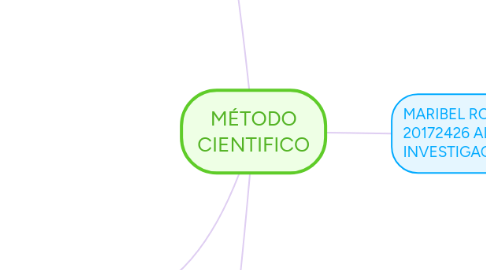
1. LA CIENCIA
1.1. Etimologia
1.1.1. Es buscar, Observar, descubrir y entender, para probar y validar o invalidar la hipótesis del desarrollo de una teoría.
1.2. Conceptualización
1.2.1. Perpectiva Diacrónica
1.2.2. Perpectiva analitica
1.3. Definición
1.3.1. conocimiento racional, sistemático, exacto, verificable y falible
1.4. Objeto
1.4.1. Conocimiento de la realidad
1.5. Objetivos
1.5.1. Analizar, Explicar, Predecir, Actuar o Aplicar
1.6. Estructura
1.6.1. Contenido
1.6.2. Campo de Actuación
1.6.3. Procedimiento o forma de Actuar
1.7. Clasificación
1.7.1. Ciencias Formales
1.7.2. Ciencias Fácticas
1.8. Esquema de Clasificación
1.8.1. Ciencia Formal
1.8.1.1. Lógica Matemática
1.8.2. Ciencias Fácticas
1.8.2.1. Natural
1.8.2.1.1. Física;
1.8.2.2. Cultural
1.8.2.2.1. Psicología Social, Sociología, Economía, Ciencias Políticas, Historia Material, Historia de las Ideas
2. METODO CIENTIFICO
2.1. Conceptualización
2.2. Clases de Métodos
2.2.1. Método Empírico- Analítico
2.2.2. Método Experimental
2.2.3. Método Hipotético- Deductivo
2.2.4. Método de Observación Científica
2.2.5. Método Hermenéutico
2.2.6. Método Dialéctico
2.2.7. Método Histórico
2.2.8. Método Sistémico
2.2.9. Método Sintético
2.2.10. Método Lógico
2.2.11. Método Lógico Deductivo
2.2.12. Método Lógico Inductivo
2.2.13. Método de Inducción Científica
2.2.14. Método Analógico
2.3. Etapas o Fases del Método Científico
2.3.1. Observar
2.3.2. Plantear el problema
2.3.3. Hacer el Hipótesis
2.3.4. Experimentar
2.3.5. Recopilación y Análisis de Datos
2.3.6. llegar a una Conclusión
3. LA INVESTIGACIÓN CIENTIFICA
3.1. Etimología
3.1.1. Es Pos Huella buscar una pista es revisar huella para encontrar la verdad.
3.2. Conceptualización
3.2.1. Al procedimiento, control y critíca que funciona a partir de un sistema.
3.3. Definición
3.3.1. Velez proceso sistemáticamente ordenado es demostración de hipótesis y desarrollo de teorías.
3.4. Funciones de la Investigación
3.4.1. Función Descriptiva
3.4.2. Función Predictiva
3.4.3. Función Explicativa
4. By the way, this is a floating topic. To create a floating topic, simply drag it away from the map center.
5. MARIBEL ROMERO MOZO 20172426 ALUMNA TALLER DE INVESTIGACIÓN UNE
5.1. Add a sibling idea by hitting ENTER
5.2. This is a sibling idea
5.3. Add a child idea by hitting TAB
5.3.1. This is a child idea
5.4. Choose icons and images to decorate your mind map
5.5. Connect topics with the arrow tool in the upper left corner of your screen
5.6. Add links, tasks or files to your topics, using the widgets in the sidebar
5.7. Change your map layout by opening the layout options in the upper left corner of your screen
5.8. Advanced
5.8.1. Open the Theme menu from the bottom of your map editor to change your map theme
5.8.2. Create a presentation of your mind map by clicking the presentation icon in the bottom left corner of your screen
5.8.2.1. Simply hold down COMMAND i.e. CTRL and Click & Drag to create a slide for one or multiple topics
5.8.2.2. Set transitions for your slides
5.8.2.3. Click "Start Slideshow" to view your presentation
5.8.3. Open the Sharing Settings from the bottom of your map editor to share the map with a friend or publish it to the web
5.8.3.1. You can share your map with anyone via email
5.8.3.2. You can publish your map and enable anyone with an internet access to find it
5.8.3.3. You can embed your map on a blog or website
